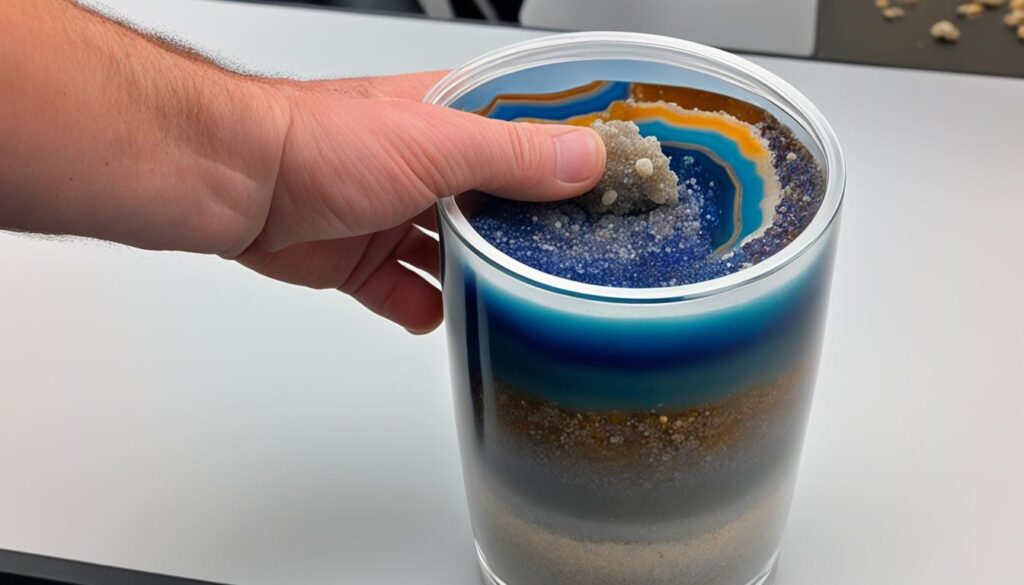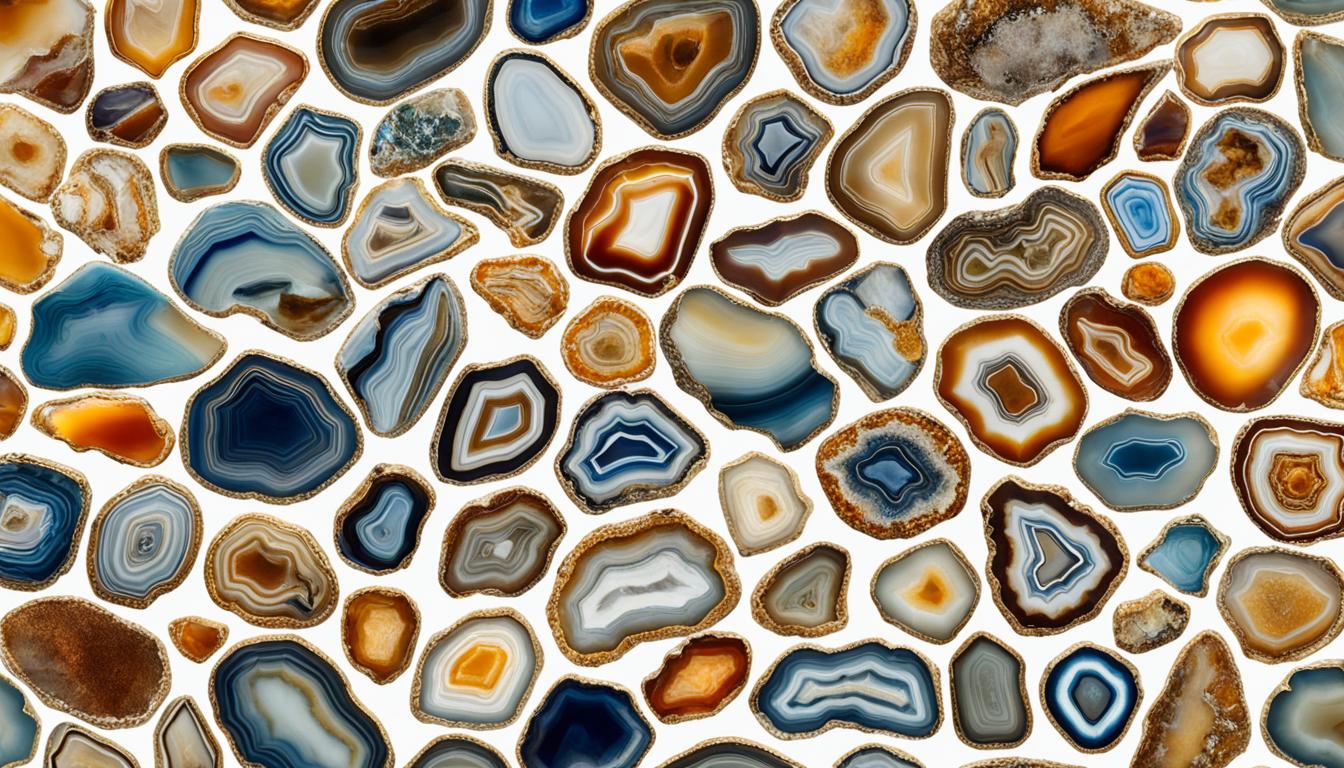This post contains affiliate links.
As a kid, I loved searching for smooth, colorful stones in the river. This hobby turned into a lifelong love for rock tumbling. The joy of turning rough agate into shiny gems never gets old. This guide is for anyone interested in rock tumbling, from beginners to pros. It will show you the best agates to tumble and how to reveal their beauty.
Agate is a top choice for tumbling because of its beautiful patterns and durability. It’s perfect for both new and experienced tumblers. You can find agates in many colors and patterns, like the bright ones from Brazil or the detailed ones called crazy lace agate.
This guide will take you through the world of agate tumbling. We’ll cover how to pick the best agates and how to tumble them. Get ready for a journey that turns ordinary rocks into stunning treasures!
Key Takeaways
- Agate is the most popular rock for tumbling due to its color, patterns, and polishing ability
- Rocks with a Mohs Hardness between 6 and 8 are ideal for tumbling
- Agate can be found worldwide, including Brazil, Uruguay, and the United States
- Small tumblers can process rocks between 3/8 and 1 1/4 inches in size
- Good tumbling rocks should be hard, dense, and free of fractures
- The tumbling process typically takes four to six weeks for small barrels
Introduction to Agate Tumbling
Agate tumbling turns simple stones into beautiful polished agate pieces. This hobby has been popular since the 1950s. It draws in rock lovers from all over the world. Let’s explore the world of agate tumbling and see its beauty.
What is Agate?
Agate is a type of chalcedony known for its colorful bands. It’s found in many places, from Brazil to Madagascar. Its hardness makes it perfect for tumbling, giving it a beautiful shine.
Benefits of Tumbling Agate
Tumbling agate has many benefits:
- Creates stunning polished gems from rough stones
- Perfect for beginners – experts recommend tumbling agate 2-3 times before trying other materials
- Versatile – other chalcedony types like carnelian and chrysoprase work well too
- Develops patience and skill in rock polishing
Essential Equipment for Agate Tumbling
To start tumbling, you’ll need:
- A rotary tumbler (like Thumler’s Model A-R2)
- Agate tumbling grit in coarse, medium, and fine grades
- Polishing compound for the final stage
- Tumbling pellets for all stages
The process takes about four weeks, with each grit stage taking a week. With the right tools and patience, you’ll soon have beautiful polished agate pieces to keep or share.
Types of Agate Best to Tumble
Agate tumbling is a fun journey into the lapidary arts. Different agates have their own challenges and rewards. They are perfect for rock polishing fans at all levels.
Brazilian Agate
Brazilian Agate is a top pick for tumbling. Its bright colors and unique banding patterns look great. Even with fractures, the right techniques can make stunning polished stones.
Prairie Agate
Prairie Agate is great for beginners. It has a smooth texture and soft colors that look beautiful when tumbled. It also needs less time at the start of the tumbling process.
Crazy Lace Agate
Crazy Lace Agate is loved for its detailed patterns and bright colors. Its complex banding makes for eye-catching designs. It takes patience but gives amazing results.
Botswana Agate
Botswana Agate is known for its beautiful, concentric banding. It has subtle colors and a smooth texture, perfect for tumbling. This agate type works well with various techniques, leading to high-quality stones with stunning patterns.
| Agate Type | Difficulty Level | Notable Features |
|---|---|---|
| Brazilian Agate | Intermediate | Vibrant colors, potential fractures |
| Prairie Agate | Beginner | Smooth texture, subtle hues |
| Crazy Lace Agate | Advanced | Intricate patterns, bold colors |
| Botswana Agate | Intermediate | Delicate banding, subtle variations |
Preparing Agate for Tumbling

Getting agate ready for tumbling is key to getting beautiful stones. First, check your rough agate stones for any broken edges or holes. These can trap grit and mess up the polish, making the process longer.
Agate’s hardness is important for tumbling. It has a Mohs hardness of 6.5 to 7. This means it can handle the rough tumbling action without breaking. It’s perfect for those who love polishing rocks.
Before you start, make sure everything is clean. Put your agate stones in the tumbler, filling it about 2/3. Then, add the right amount of grit for your tumbler size. Here’s what you need:
- 2 lb tumbler: 3 tablespoons (45 g) of grit
- 3 lb tumbler: 4 tablespoons (60 g) of grit
- 6 lb tumbler: 8 tablespoons (120 g) of grit
Next, add water to almost cover the rocks. This mix is perfect for tumbling agate stones. It starts a polishing process that takes weeks through different stages.
The Tumbling Process for Agate
Agate tumbling turns rough stones into shiny gems. It’s a process with many steps, each important for the perfect shine. Let’s look at agate lapidary techniques and how to use agate tumbling grit well.
Coarse Grit Stage
The first step uses coarse grit, like 60/90 mesh. This stage shapes the agate and smooths big imperfections. It’s key to match stones by size and hardness for the best results.
Medium Grit Stage
Then, the medium grit stage comes, using 150/220 mesh. This refines the surface more, getting it ready for finer grits. Always clean your rocks and barrel well between steps to avoid mixing grits.
Fine Grit Stage
The fine grit stage, with 500F grit, highlights the agate’s natural shine. This step makes your stones sparkle. Remember, be patient with rock tumbling.
Polishing Stage
The last stage uses TXP Polish for a glossy finish. Each stage takes about a week, sometimes needing a coarse grit repeat for the best look.
| Stage | Grit Size | Duration | Purpose |
|---|---|---|---|
| Coarse | 60/90 mesh | 1-2 weeks | Shape and smooth |
| Medium | 150/220 mesh | 1 week | Refine surface |
| Fine | 500F | 1 week | Enhance luster |
| Polish | TXP Polish | 1 week | Achieve glossy finish |
Tips for Achieving a High-Quality Polish on Agate

To get a beautiful shine on your agate, pay close attention to details and use the right methods. Here are expert tips for making agate jewelry that shines.
First, make sure your rocks are shaped and smoothed well before polishing. Use high-quality grit and polish, and fill your barrel just right for the best results. Always clean your rocks and barrel between steps to avoid contamination.
For a 3lb tumbler, mix 4 level tablespoons of polish powder with 300ml of water. A 4lb tumbler needs 9 level tablespoons with 600ml of water. You can reuse the polish mix up to six times, but change it if it turns grey.
Adding a burnishing step with borax for 48 hours can improve your agate’s polish. Use 1 level tablespoon for a 3lb tumbler and 2 for a 4lb tumbler. This step can make your agate shine even more.
Keep a tumbling log to track your steps. This helps you improve your technique over time, leading to better results.
| Tumbler Size | Polish Powder | Water | Borax (Burnishing) |
|---|---|---|---|
| 3lb | 4 tablespoons | 300ml | 1 tablespoon |
| 4lb | 9 tablespoons | 600ml | 2 tablespoons |
Patience is crucial in agate tumbling. It usually takes about a month, but the actual work time is just a few hours. Your final polish should make the rocks look wet and shiny, perfect for beautiful agate jewelry.
Common Challenges in Agate Tumbling and How to Overcome Them
Agate tumbling is a fun hobby but has its challenges. Let’s look at common issues and how to fix them.
Dealing with Fractures and Inclusions
Rough agate stones often have cracks or inclusions that can mess up the polish. Check your stones before you start tumbling. Take out any pieces that are too broken to work with. For small cracks, use agate tumbling grit to slowly smooth them out. This way, you keep the stone whole and get a smooth finish.
Avoiding Over-tumbling
Over-tumbling can make your rocks smaller and lose their special look. Watch how long you tumble your stones. Each step usually takes about 10 days. Keep an eye on them and adjust as needed. It’s safer to tumble a bit less than to lose too much stone.
Maintaining Proper Barrel Fill
As your stones get smaller, it’s important to keep the right amount of fill in the barrel. Start with the barrel about ¾ full of stones. When they shrink, add ceramic media to keep it half full. This keeps the stones tumbling right and stops them from bouncing too much.
By tackling these challenges, you’ll get better at making beautiful agates. Remember, patience is key. Some people even polish their stones by hand for the best look. With practice and effort, you’ll get the hang of agate tumbling.
Showcasing Your Polished Agate: Display and Jewelry Ideas
After tumbling your agate, it’s time to show off your polished agate specimens. Whether you’re into making agate jewelry or creating stunning displays, there are many ways to highlight these beautiful stones.
For agate jewelry making, think about making pendants, earrings, or bracelets. You can easily make key chains and pendants by gluing on bell caps. Some people even cut tumbled stones in half to make unique rock heart shapes.
If you like displaying your polished agate, try putting them in glass bowls or shaped containers. These displays look great on coffee tables or bookshelves. You can also use tumbled stones to decorate potted plants or aquariums, adding natural beauty to your home.
| Display Ideas | Jewelry Ideas |
|---|---|
| Glass bowls | Pendants |
| Shaped containers | Earrings |
| Around potted plants | Bracelets |
| In aquariums | Key chains |
For those who want to share their love for agate, consider offering tumbled rocks for geocaching or hiding them in playgrounds for kids to find. This spreads joy and introduces others to the world of agate collecting.
Showcasing your polished agate specimens is not just about display. It’s about sharing the beauty and wonder of these natural treasures with others.
Where to Find Quality Agate for Tumbling
Finding quality agate is essential for making beautiful polished stones. Rock lovers have many places to get agate for tumbling.
Reputable Online Suppliers
Many rock hobbyists buy agate from trusted online sellers. The Rock Shed is a top choice, offering a wide variety of types of Agate best to tumble. They sell Crazy Lace Agate, a favorite since the 1960s, in two-pound packages for $22.99. This hard material, with a Mohs hardness of 7, produces beautiful tumbled stones.
Rockhounding Locations
For those who love outdoor adventures, rockhounding is a great way to find agate. Look for agate in:
- Streambeds
- Riverbanks
- Areas with water erosion
When searching, look for pieces with interesting patterns and colors. Agate’s hardness of 7 makes it perfect for tumbling and polishing.
Rock and Gem Shows
Going to rock and gem shows is a great way to find quality agate rough. These events bring together sellers with diverse agate gemstone varieties. You can check out pieces up close and get advice on the best types for tumbling.
“Agate tumbling is not just a hobby; it’s an art form that transforms nature’s raw beauty into polished treasures.”
Whether you pick online suppliers, rockhounding, or gem shows, choosing the right agate is key for successful tumbling. With patience and practice, you’ll soon be making stunning polished stones from these amazing agate varieties.
Conclusion
Agate tumbling is a journey into the lapidary arts. It’s filled with different types and beautiful patterns. Each type of agate adds its own charm to your projects.
Learning agate lapidary techniques takes time and effort. It turns rough stones into shiny treasures. These stones show off their beauty with intricate bands and bright colors. The best agates for tumbling are those rated 5 to 7 on the Mohs scale. This ensures they stay strong during polishing.
As you dive into this hobby, try out different agates. Each stone has its own story, like the fiery colors of Condor Agate or the soft patterns of Moss Agate. With patience and the right tools, you’ll make stunning, polished stones that show off nature’s beauty.
FAQ
What is agate and why is it a good choice for tumbling?
What types of agate are recommended for beginners?
What equipment is needed for tumbling agate?
How do I prepare agate for tumbling?
What are the stages of the tumbling process for agate?
How can I achieve a high-quality polish on agate?
What are some common challenges when tumbling agate?
How can I showcase my polished agate?
Where can I find quality agate for tumbling?
This post contains affiliate links.

